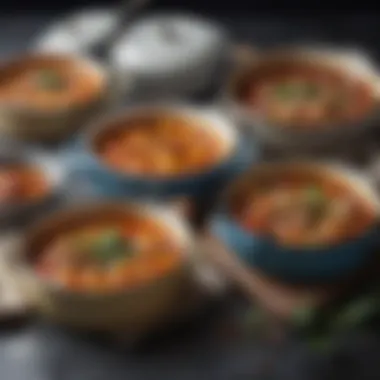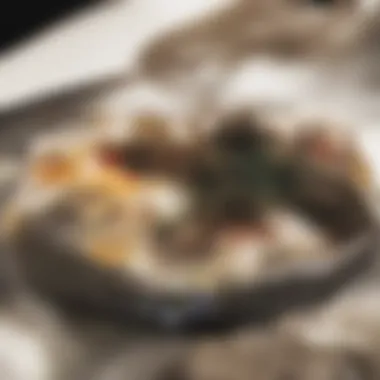The Versatile Enamel Casserole Dish: A Culinary Essential


Intro
Enamel casserole dishes have long been a staple in many kitchens around the globe. Their versatility extends well beyond simply being a cooking vessel. They are capable of serving a dual purpose: preparation and presentation. This article aims to illuminate the multifaceted role of these dishes in modern culinary practices.
The journey into the world of enamel casserole dishes begins with their rich history, tracing their evolution from simple kitchen tools to highly sought-after culinary assets. Their material benefits, due to enamel-coated surfaces, make them attractive for health-conscious cooks. Additionally, understanding the techniques for maintaining these valuable tools is crucial for any culinary enthusiast.
Moreover, the diverse cooking methods applicable to enamel casserole dishes enhance their usability. Whether slow-cooking, baking, or even sautéing, these dishes can accommodate various culinary styles. As we delve further into the article, we will uncover how they can elevate both everyday cooking and more exquisite dining experiences.
This comprehensive guide caters to food lovers across all skill levels, aiming to impart knowledge and foster appreciation for this essential kitchen tool.
Prelude to Enamel Casserole Dishes
Enamel casserole dishes are an essential component in many kitchens today. They offer versatility, functionality, and aesthetic appeal. Their design allows for seamless transitions from stovetop to oven, and then to the dining table, making them a practical choice for home cooks and chefs alike. One must consider the benefits of these dishes, as they not only enhance cooking techniques but also serve to elevate everyday meals.
Understanding Enamel Coating
The enamel coating on these casserole dishes plays a significant role in their functionality. It consists of a glass-like material fused to metal, commonly cast iron or steel, through a high-temperature process. This coating provides a smooth, non-porous surface, which is crucial for ease of cleaning and maintenance. Unlike bare metal cookware, enamel coating does not react with acidic foods, ensuring that flavors remain pure and untainted.
It also serves as a protective layer, preventing rust and improving durability. Given these factors, the enamel coating makes these dishes a reliable choice for various cooking methods.
Historical Perspective
The use of enamel in cookware has a rich history that dates back to the 18th century. Initially popularized in Europe, enamel-coated cookware became favored for its beauty and resilience. Notably, French artisans played a significant role in elevating the craftsmanship of enamel casserole dishes, combining function with art.
Over the years, different regions have developed their unique styles and uses for these dishes, adapting to culinary needs and tastes. Understanding this historical context provides insight into the enduring popularity of the enamel casserole dish in contemporary kitchens.
The blend of practicality and artistry in enamel cookware has made it a staple in many households for centuries.
Material Composition and Benefits
The material composition of enamel casserole dishes is crucial for understanding their utility and longevity in the kitchen. The enamel coating, derived from glass and ceramic components, provides a unique combination of qualities. These features include durability, thermal conductivity, and non-reactive properties, which collectively enhance cooking performance.
Durability and Longevity
Enamel casserole dishes are renowned for their impressive durability. The enamel coating protects the underlying cast iron or steel, making these dishes resistant to scratches and chips. Unlike other cookware, enamel resists wear and tear from daily use. With proper care, an enamel casserole dish can last for decades. This longevity translates into both economic and environmental benefits, as fewer replacements mean reduced waste. When investing in cookware, durability is a significant consideration. High-quality enamel casserole dishes, such as those from Le Creuset or Staub, provide a lasting addition to any kitchen.
Thermal Conductivity
Thermal conductivity is another essential quality of enamel casserole dishes. The materials used in these dishes allow for even heat distribution. This means food cooks uniformly, reducing the risk of hot spots that can lead to uneven cooking. The enamel layer enhances this property further, ensuring that heat retention and transfer are optimized. For instance, when baking or roasting, a well-made enamel casserole can maintain steady temperatures, crucial for recipes that require precise cooking times.
Non-Reactive Properties
Non-reactive properties of enamel casserole dishes are vital for those who prioritize health and flavor in their cooking. Unlike some metals, enamel does not react with acidic foods, such as tomatoes or vinegar. This characteristic ensures that the flavors of your dishes remain pure and true to the ingredients. Moreover, using a non-reactive surface means that harmful compounds do not leach into the food.
Enamel casserole dishes are a safe choice for preparing a variety of dishes, from hearty stews to delicate sauces. Choosing the right one can enhance both the cooking experience and the final dish.
In summary, understanding the material composition and benefits of enamel casserole dishes aids in making informed choices in the kitchen. Their durability, excellent thermal conductivity, and non-reactive nature make them essential tools for any culinary enthusiast.
Design and Aesthetics
The design and aesthetics of enamel casserole dishes play a significant role in their appeal and functionality. Their visual presence in the kitchen can elevate the cooking experience. Aesthetic value is often defined by color, shape, and overall style, which can complement various kitchen themes. This dual aspect of utility and beauty makes them attractive to culinary enthusiasts.
In addition to being functional, these dishes are also considered home decor. Colorful and stylish designs invite creativity in the kitchen. A well-chosen casserole dish can become a centerpiece on the dining table, showcasing the dish prepared within. The aesthetic appeal of these dishes cannot be overstated; it encourages cooking and serving with pride.


Color and Style Variations
Color and style variations in enamel casserole dishes are vast. They come in multiple shades and patterns, allowing personalization in kitchen spaces. For example, brighter colors like red or turquoise can add vibrancy, while neutral tones such as white or beige offer a classic look. These variations cater to personal taste and can influence the atmosphere of family gatherings or dinner parties.
The enamel coating allows for intricate designs, which can add an artistic flair. Some manufacturers offer limited-edition patterns that appeal to collectors.
When selecting a casserole dish, consider how its color and style will fit within your kitchen's overall aesthetic. A mismatched piece may disrupt the flow of your kitchen's design. Therefore, look for dishes that harmonize with your existing cookware.
Functional Design Elements
Functional design elements are essential in determining how easy and enjoyable a casserole dish is to use. First, consider the dish's shape. Round, oval, and rectangular designs serve different types of cooking needs. For instance, an oval dish is ideal for roasting meats, while a round dish works well for baking casseroles.
Handles are another vital design feature. Well-designed handles make it easy to lift and maneuver the dish, especially when hot. Consider handles that stay cool to the touch, as they enhance safety in handling. Additionally, a tight-fitting lid can help retain moisture during cooking, ensuring even heat distribution and optimal flavor.
Lastly, consider the dish's base. A smooth base will ensure even cooking across all areas. An uneven base can lead to hot spots and burnt food. Look for enamel casserole dishes that have been well-crafted to avoid these issues.
The design of an enamel casserole dish can significantly influence not only its functionality but also its place in the heart of a home kitchen.
Culinary Techniques with Enamel Casseroles
Enamel casserole dishes stand out in the culinary world, serving as a versatile tool for various cooking methods. Their robust design and heat retention qualities make them suitable for both slow-cooking recipes and high-heat applications. Understanding the techniques you can employ with enamel casseroles expands culinary possibilities, ensuring that each dish emerges with optimal flavor and texture.
Baking and Roasting
One of the primary strengths of enamel casserole dishes is their capacity to bake and roast. They distribute heat evenly, which is essential for achieving that perfect crust on bread or a beautifully roasted chicken. When baking, the enamel coating contributes to an easy release of your food, thereby preventing unwanted sticking.
When using an enamel casserole for baking, consider the dimensions and shape. Round or oval dishes often excel at baking casseroles, while rectangular dishes may be more effective for lasagna or cake. The color of the enamel can also impact the baking process; darker colors absorb heat more efficiently, affecting the final results.
Stewing and Braising
Stewing and braising are techniques where enamel casserole dishes truly shine. Their ability to retain heat allows for low and slow cooking, which is crucial for developing rich flavors. These dishes maintain moisture effectively, making them ideal for tougher cuts of meat that benefit from extended cooking times.
To maximize the benefits when stewing, layer your ingredients thoughtfully. Begin with a base of aromatics such as onions and garlic, then add meat and vegetables in a way that promotes even cooking. The heavy lid of the enamel casserole helps keep in steam and flavor, creating a tender finish. This method not only improves flavor but also ensures a pleasing presentation when served.
Serving and Presentation
Enamel casserole dishes are beautiful enough to go directly from the oven to the table. Their aesthetic appeal complements the vibrant colors of the food they hold. Serving from these dishes enhances the dining experience, allowing guests to appreciate both the meal and its presentation.
Utilizing the casserole as a serving dish underscores the home-cooked feel of a meal, inviting conversation among diners. When plating, consider garnishing your dish for added color and visual interest. Transferring food from the casserole can create a less intimate dining experience, so it is often better to serve directly from the dish.
Serving directly from an enamel casserole not only looks inviting but also streamlines the dining experience.
In summary, employing enamel casserole dishes enhances numerous culinary techniques. Their durability and heat retention lend themselves well to baking, roasting, stewing, and braising. Furthermore, the elegant designs invite both appreciation and convenience during meal presentations.
Selecting the Right Casserole Dish
Choosing the right casserole dish is not just about aesthetics or brand reputation. It plays a critical role in achieving culinary success. The right enamel casserole dish can elevate a simple recipe into a delightful experience. Understanding specific elements such as size, capacity, and quality is essential for any cooking enthusiast.
Size and Capacity Considerations
The size of a casserole dish should align with your cooking needs. Smaller dishes are suitable for side dishes or serving a couple of people, while larger capacities fit well for family gatherings or meal prepping. When selecting the size, consider your typical cooking habits. Do you often host dinner parties? A larger casserole might be better. If you frequently prepare smaller meals, a compact option would fit.


Additionally, think about storage space in your kitchen. An oversized casserole that does not fit your cabinet can become an inconvenience. It's also important for heat distribution. A dish that is too full can lead to uneven cooking. The general rule is to leave a little space at the top to allow for bubbling or rising of ingredients.
"The right size casserole dish ensures an effortless cooking experience, preventing overcrowding and ensuring even heat distribution."
Choosing Quality Brands
When it comes to enamel casserole dishes, the brand can offer insights into quality and reliability. A reputable brand often uses high-quality materials that influence the longevity and performance of the dish. Well-known brands like Le Creuset and Staub have built a reputation through years of consistent quality and durability.
When selecting a brand, look for the following attributes:
- Material Quality: High-quality enamel coating is crucial. This will not only affect how well the dish cooks but also how easy it is to clean.
- Customer Reviews: Reviews can provide a real-world perspective on durability and performance over time. Many cooking forums or sites like reddit.com give detailed insights.
- Warranty Information: A good warranty can indicate the brand's confidence in its product. Brands that stand behind their products showcase commitment to customer satisfaction and quality.
Making an informed decision when purchasing an enamel casserole dish can significantly enhance your cooking journey.
Maintenance and Care
The longevity and performance of enamel casserole dishes significantly depend on how they are maintained and cared for. Proper maintenance not only enhances their appearance but also ensures their functionality throughout the years. Caring for your enamel casserole dish can prevent chipping and staining, thereby preserving its quality and your investment.
Cleaning Techniques
Keeping your enamel casserole dish clean is essential to its upkeep. While enamel is generally resistant to food sticking, a few simple techniques can enhance its longevity:
- Immediate Cleaning: After using, it is beneficial to clean the dish while it is still warm, but not hot. This makes it easier to remove food residue.
- Gentle Scrubbing: Use a soft sponge or cloth. Avoid steel wool or harsh abrasive scrubbers, as these can scratch the enamel surface.
- Soak Stubborn Stains: If there are tough stains, soak the dish in warm, soapy water for about 15-20 minutes. This often loosens stuck-on food without scrubbing.
- Non-Acidic Cleaners: Opt for cleaners that are non-acidic. Acidic substances can wear down the enamel over time.
- Rinse and Dry Thoroughly: After cleaning, ensure that you rinse the dish thoroughly to remove any soapy residue, and dry it completely to prevent moisture build-up.
Following these steps will keep your enamel casserole dish looking great and performing well.
Storage Best Practices
Proper storage of enamel casserole dishes is equally important. The way you store these dishes can impact their condition:
- Stacking Carefully: If stacking, ensure that you place a soft cloth or paper towel between dishes to prevent chipping.
- Avoid High Humidity: Store the dishes in an environment with low humidity to avoid moisture accumulation.
- Use Safe Locations: Keep them in a cabinet where they are less likely to be bumped or knocked over.
- Avoid Heavy Items on Top: Avoid placing heavy items on top of your enamel casserole dishes to prevent bending or deformation.
By implementing these practices, you can extend the life of your enamel casserole dish, making it a cherished tool in your kitchen for years to come.
Culinary Applications
Culinary applications play a crucial role in illustrating the versatility of enamel casserole dishes. These culinary tools can be adapted to various cooking methods and diverse cuisines, thereby enriching the cooking experience. An enamel casserole dish serves not just as a cooking vessel, but also as a medium for creative expression in food preparation. Their design allows for slow cooking, baking, and even serving directly at the table, making them a practical choice for both novice and seasoned cooks.
Diverse Recipe Ideas
When considering recipe ideas for enamel casserole dishes, there is a range of options that capitalize on their strengths. From hearty stews to elegant bakes, the possibilities are extensive. Here are some remarkable recipes to try:
- Beef Bourguignon: A classic French stew where beef is braised with red wine, onions, and mushrooms. The enamel's heat retention ensures even cooking.
- Vegetable Lasagna: Layer fresh vegetables and cheese for a colorful and satisfying dish that browns beautifully in the oven.
- Chicken and Rice Casserole: Combine chicken, rice, and herbs for a wholesome meal that cooks evenly in one vessel.
- Apple Crisp: Bake tart apples with a crumbly topping for a delightful dessert that can be served warm.
Each recipe highlights the casserole's capacity to meld flavors while contributing to an aesthetically pleasing dish suitable for any table setting.
Regional Dishes from Around the World
Enamel casserole dishes are also integral to traditional cooking methods in various cultures. Here are a few regional dishes that showcase their global significance:
- Tagine from Morocco: A slow-cooked savory stew, usually featuring meat, vegetables, and a blend of spices. The cone-shaped lid of tagine works similarly to enamel casserole dishes, promoting moisture retention and flavor concentration.
- Rataouille from France: This rustic vegetable dish benefits from slow, even cooking, allowing flavors to meld beautifully.
- Biryani from South Asia: Layered rice dish that can be prepared in an enamel casserole to achieve the unique “dum” cooking method, enhancing aromas and taste.
- Cassoulet from Southwestern France: A slow-cooked casserole made with meat and white beans, something that enamel dishes excel in due to their heat distribution.


These examples underline the adaptability of enamel casserole dishes across culinary traditions, reinforcing their status as a kitchen essential.
"Enamel casserole dishes not only enhance cooking but also foster global culinary traditions."
Environmental Impact
The environmental impact of kitchenware often goes unnoticed, yet it is a crucial element in the conversation about culinary sustainability. The production, use, and disposal of cooking materials significantly affect our planet's health. Enamel casserole dishes, while beloved for their cooking capabilities, also offer advantages in terms of sustainability and recyclability. It is essential to understand these aspects to appreciate fully how these versatile cookware pieces can fit into a more responsible and ecologically friendly kitchen.
Sustainable Choices
When considering sustainable choices in kitchenware, the materials used are paramount. Enamel casserole dishes are often made with cast iron or steel bases, coated with a glass-like enamel. This coating is non-toxic, which is a significant step toward reducing harmful substances in food preparation. Moreover, choosing enamel over non-stick alternatives can help avoid the perils associated with certain chemicals found in traditional non-stick coatings, especially PFOA and PFAS.
In addition, many reputable brands focus on sustainable manufacturing processes. These might include practices like reducing waste during production and sourcing materials ethically. Therefore, when purchasing, looking for brands that prioritize sustainability can enhance your commitment to environmental stewardship.
Recyclability of Materials
Recyclability is another important factor to consider. Enamel casserole dishes can be recycled, though this may depend on local recycling capabilities. The core materials, such as cast iron, are quite recyclable. The enamel coating, while non-biodegradable, can often be separated during recycling operations, allowing the underlying metal to be repurposed.
"Investing in enamel cookware not only benefits you but also the environment, making it a sensible choice for conscientious consumers."
It's worth noting that some brands offer programs to return old dishes for recycling, minimizing landfill contribution. Educating oneself on local recycling processes can greatly enhance the lifecycle of these kitchen essentials. The importance of integrating such knowledge into culinary practices cannot be understated; it allows for a more sustainable approach to cooking. In this way, enamel casserole dishes are not only valuable in the kitchen but can also play a role in a larger environmental narrative.
Comparison with Other Cookware
Understanding how enamel casserole dishes compare with other types of cookware is essential for any cooking enthusiast. This section is intended to provide insights into the unique qualities that enamel casserole dishes hold when compared to alternatives like cast iron and non-stick cookware. Recognizing the benefits and limitations of each type aids in making informed choices for different cooking methods and recipes.
Comparative Analysis with Cast Iron
Enamel casserole dishes often draw comparisons to cast iron cookware. Both materials have their dedicated followers, and each has its merits. Cast iron cookware is known for its exceptional heat retention and can be used on the stovetop and in the oven. However, it requires significant maintenance to prevent rust and to maintain its seasoning. Enamel-coated cast iron, like that seen in brands such as Le Creuset, offers some of the benefits of cast iron but with an easier cleaning process.
- Heat Distribution: Enamel casserole dishes generally offer more even heat distribution than traditional cast iron. This quality is crucial for cooking techniques requiring uniform heat, such as braising.
- Maintenance: Unlike cast iron, which demands regular seasoning and can rust, enamel casserole dishes are non-reactive and are dishwasher safe, making them less daunting to clean.
- Versatility: While both types are versatile, enamel casserole dishes are often more suited for acidic dishes. The non-reactive surface of enamel does not interact with ingredients like tomatoes or vinegar, a potential issue for bare cast iron.
Functionality Against Non-Stick Cookware
Non-stick cookware is popular in many kitchens due to its convenience and ease of use. However, it has certain limitations when compared to enamel casserole dishes, particularly regarding cooking techniques and food quality.
- Durability: Enamel casserole dishes are typically more durable than non-stick pans, which can scratch and lose their coating over time. This gives enamel dishes a longer lifespan when used appropriately.
- Versatility in Cooking Methods: Enamel casserole dishes can handle higher temperatures than most non-stick options, making them suitable for a range of techniques, from baking to slow cooking.
- Flavor Development: Certain non-stick surfaces can limit the browning and searing processes, which are vital for developing deep flavors in dishes like stews or braises. Enamel allows for better Maillard reactions, enhancing the overall taste.
When considering options, the choice between non-stick and enamel cookware should align with cooking style and the type of meals being prepared. Enamel casserole dishes thrive in versatility, offering robust performance without the risks associated with non-stick coatings.
Culmination
In this article, we explored the multifaceted role that enamel casserole dishes play within modern culinary practices. These versatile kitchen essentials present numerous benefits stemming from their unique material composition, design aesthetics, and performing capabilities.
Enamel casserole dishes stand out for their durability and longevity, ensuring they become integral parts of any kitchen for years. Their excellent thermal conductivity allows for evenly cooked meals, whether baking, stewing, or roasting. Scenario after scenario reveals how non-reactive properties support various cooking methods without risking flavor contamination, making them ideal for a multitude of cuisines.
Summing Up the Importance of Enamel Casserole Dishes
Enamel casserole dishes are not just for cooking; they also elevate the experience of food preparation and presentation. The inherent versatility means they seamlessly transition from oven to table. This functionality streamlines the cooking process and enhances overall aesthetics with an array of beautiful designs and colors.
Their importance is also apparent in sustainable practices. With proper care, these cookware pieces reduce waste and avoid the pitfalls of disposable alternatives. Enamel casserole dishes help bolster an eco-friendly kitchen, as they are made from recyclable materials. They provide both environmental and practical benefits, making them essential for the conscious home chef.
Encouraging Exploration in Cooking Practices
Embracing the use of enamel casserole dishes invites culinary exploration. The unique qualities of enamel enable cooks of all levels to try diverse techniques, including slow cooking, baking, and braising. It encourages experimentation with regional dishes from around the world, as this cookware allows for a variety of recipes to shine through.
Engaging in these practices fosters a deeper connection with food and highlights the importance of choosing quality cookware.







